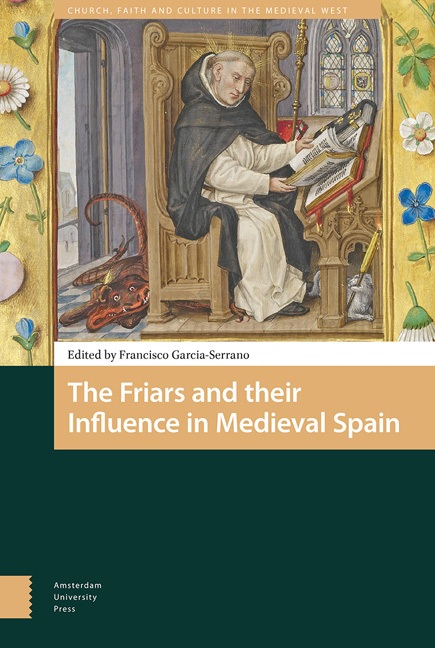Book contents
- Frontmatter
- Contents
- Abbreviations
- List of Illustrations
- Acknowledgements
- Introduction
- 1 Dominicus Hispanus
- 2 Ramon de Penyafort and His Influence
- 3 The Mendicant Orders and the Castilian Monarchy in the Reign of Ferdinand III
- 4 Ramon Marti, the Trinity, and the Limits of Dominican Mission
- 5 Narrative and Counter-Narrative: Dominican and Muslim Preaching in Medieval Iberia
- 6 The Poor Clares of Alcocer and the Castilian Crown (Thirteenth to Fifteenth Centuries)
- 7 Friars and Nuns: Dominican Economy and Religious Identity in Medieval Castile
- 8 Networks of Dissent and the Franciscans of the Crown of Aragon
- 9 Faction, Politics, and Dominican Inquisitors in the Fourteenth-Century Crown of Aragon
- 10 Sutzura e Viltat Carnal: The Place of Sin and Lust in the Treatises of the Franciscan Francesc Eiximenis (c.1400)
- 11 Valencian Dominicans Beyond the Convent of Santo Domingo
- 12 Ferdinand of Antequera and Santo Domingo el Real de Toledo: Patronage, Advice, and Spiritual Favour (c.1390–1416)
- Index
1 - Dominicus Hispanus
Published online by Cambridge University Press: 16 February 2021
- Frontmatter
- Contents
- Abbreviations
- List of Illustrations
- Acknowledgements
- Introduction
- 1 Dominicus Hispanus
- 2 Ramon de Penyafort and His Influence
- 3 The Mendicant Orders and the Castilian Monarchy in the Reign of Ferdinand III
- 4 Ramon Marti, the Trinity, and the Limits of Dominican Mission
- 5 Narrative and Counter-Narrative: Dominican and Muslim Preaching in Medieval Iberia
- 6 The Poor Clares of Alcocer and the Castilian Crown (Thirteenth to Fifteenth Centuries)
- 7 Friars and Nuns: Dominican Economy and Religious Identity in Medieval Castile
- 8 Networks of Dissent and the Franciscans of the Crown of Aragon
- 9 Faction, Politics, and Dominican Inquisitors in the Fourteenth-Century Crown of Aragon
- 10 Sutzura e Viltat Carnal: The Place of Sin and Lust in the Treatises of the Franciscan Francesc Eiximenis (c.1400)
- 11 Valencian Dominicans Beyond the Convent of Santo Domingo
- 12 Ferdinand of Antequera and Santo Domingo el Real de Toledo: Patronage, Advice, and Spiritual Favour (c.1390–1416)
- Index
Summary
Abstract
Saint Dominic of Osma was probably born in Caleruega (Spain) around the year 1170. He died in Bologna (Italy) in 1221. His life and work are well known from the founding of the nunnery of Prouille in 1206 and the establishment of the Order of Preachers in 1215. However, his previous life, i.e. two-thirds of his life (1170–1206), is little known. Jordan of Saxony, who briefly met Dominic in 1219 and never went to Spain, gives very few details on this period. This chapter aims to emphasize the intellectual background of Dominic through his formation in the see of Osma and his education at the University of Palencia, which made him one of the most brilliant Hispani who influenced the Europe of his time.
Keywords: Saint Dominic, Dominicans, medieval Castile, religious history
Dominicus Hispanus? The title may well surprise a reader since the Hispanic origin of the founder of the Order of Preachers is usually held to be of little importance, except to specify where he was born and in order to make mention of his mother, Juana of Aza. This could not be more different from the case of the man with whom he is most often compared, Francis of Assisi, whose Italian origins are always emphasized. Yet, unlike many of his contemporaries – such as the jurists Bernardus Compostellanus, Vicentius Hispanus, Laurentius Hispanus, Petrus Hispanus, and many others who became famous outside of their homeland – it appears that the term Hispanus is considered unnecessary to understand the life and work of Saint Dominic.
Scholars who have studied his life and works – such as the French Marie-Humbert Vicaire, the Belgian Pierre Mandonnet, the Spanish Luis G. Alonso Getino, and more recently the English Simon Tugwell – have been faced with many difficulties because of the sparse information available about the first Preacher's early life. It is only when Dominic leaves Spain and arrives in what is now southern France and is about to found the convent of Our Lady of Prouille in 1206 that he becomes a ‘public figure’. If, according to tradition, we accept the date of 1170 for his birth, he was then already about forty years old.
- Type
- Chapter
- Information
- The Friars and their Influence in Medieval Spain , pp. 19 - 44Publisher: Amsterdam University PressPrint publication year: 2018
- 1
- Cited by

